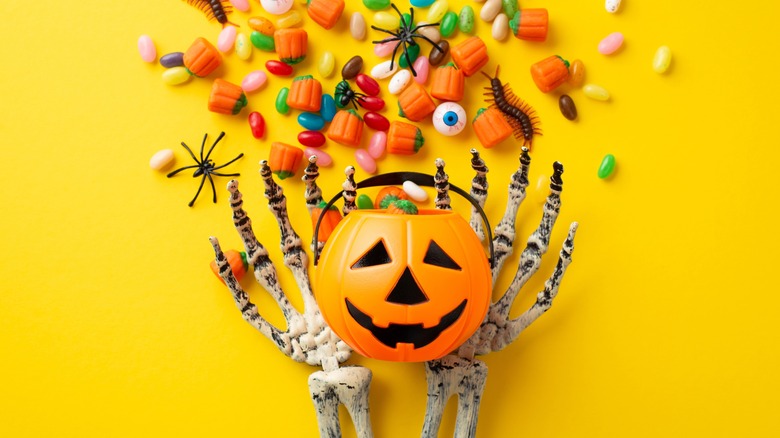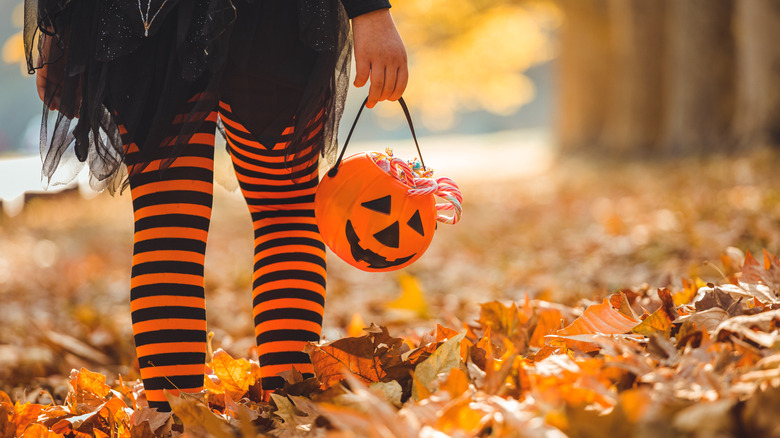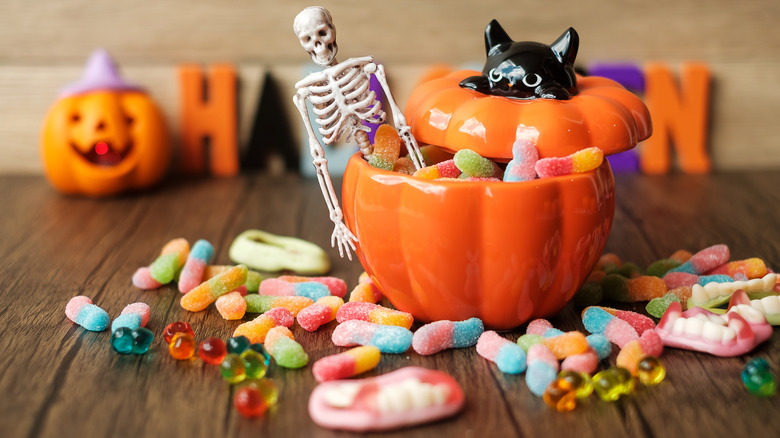Why You Really Don't Need To Worry About Poison-Laced Halloween Candy
Halloween is all about putting a playful twist on terror, but one very serious fear has gripped Americans for decades. Every October, news outlets seem to warn parents to inspect every piece of candy their child brings home for signs of tampering, as they may have been laced with poison or packed with razor blades. Many of us were cautioned as children not to accept anything but factory-sealed candy on Halloween and told to be suspicious of anyone handing out homemade treats.
These purported acts of murder-by-candy have been dubbed "Halloween sadism," a term coined in a 1974 PTA Magazine article. The panic has been stoked throughout the years by major newspapers and networks, which tend to frame the danger as a matter of when not if. Abigail Van Buren, the legendary "Dear Abby," once wrote a column titled "A Night of Treats, Not Tricks," in which she warned that "Somebody's child will become violently ill or die after eating poisoned candy or an apple containing a razor blade." She stated this as a certainty, but was there actually any proof?
It turns out fears of poisoned Halloween candy hold little more validity than ghost stories. Despite the widespread panic, no confirmed cases of children killed by contaminated candy during trick-or-treating have been verified. A few news stories have pinned children's deaths on Halloween sadists, but each of these cases was later attributed to another cause. And yet, the panic persists.
How did we become so scared of poisoned candy?
Fears of Halloween sadism go back almost as far as the origin of modern trick-or-treating. Many peg the beginning of this panic on a 1959 case in which California dentist William Shyne coated laxatives in candy and gave them to trick-or-treaters, 30 of whom got sick. In 1964, Helen Pfeil of Long Island gave poison ant traps, steel wool, and dog biscuits to children she felt were too old to trick-or-treat, though it ultimately did no harm.
In 1970, The New York Times ran an article claiming, "Red hot pennies heated in an oven were often handed out to trick-or-treaters by sadistic householders," but there was no actual evidence of this. A doctor interviewed by the Times blamed Halloween sadism on "the permissiveness in today's society."
There was one legitimate case of fatal poisoning by Halloween candy, but it wasn't the kind we've been taught to fear. In 1974, a Texan named Ronald O'Bryan gave cyanide-laced Pixy Stix to five kids. One of them ate the candy and died. It was O'Bryan's own son, and an investigation revealed that O'Bryan had taken out a hefty life insurance policy on the boy shortly before. The other children were friends of O'Bryan's son, and while the man never confessed to the crime, it was clearly a targeted attack, not an indiscriminate poisoning of trick-or-treaters. Nevertheless, the act seemed to cement a fear of deadly Halloween candy in the public consciousness.
What the facts say
If you're worried about poison-laced Halloween candy, there's one man you need to hear from. Joel Best is a sociology and criminal justice professor at the University of Delaware who has studied Halloween sadism since the 1980s. Over four decades of research, Best has consistently found that stories of poisonous candy and razor-filled apples are myths. To explain the panic, Best notes that coverage of Halloween sadism tends to spike in the aftermath of widely publicized threats to public safety, such as the 9/11 attacks and the unsolved 1982 Tylenol murders, in which seven people in the Chicago area died from taking cyanide-laced Tylenol one month before Halloween.
Combing through news coverage dating back to the 1950s, Best uncovered five cases in which children were initially thought to have died from tampered Halloween treats. One was the aforementioned O'Bryan case — a targeted attack — one involved a boy who ingested heroin, which was later determined to have come from a family member, and the remaining three were ultimately attributed to medical issues. Best has found no confirmed instances of death by random poisoning of trick-or-treaters.
Best's public profile has risen recently, with several publications interviewing him and citing his research. This reflects a gradual shift in news coverage of Halloween sadism, focused on debunking the public's fear rather than stoking it. Hopefully, these worries will be quelled someday, and we can embrace trick-or-treating as the joyful act it's meant to be.


